Whether you’re someone interested in maritime history, or you’re a little worried about taking a cruise for the first time, you might want to learn more about the number of times that cruise ships have sunk.
It’s a very rare occurrence and even when it does happen, modern safety protocols mean that most if not all passengers and crew will be perfectly safe.
So, let’s sate that interest (or quell those fears) with a guide on the cruise ships that have sunk in recent times.
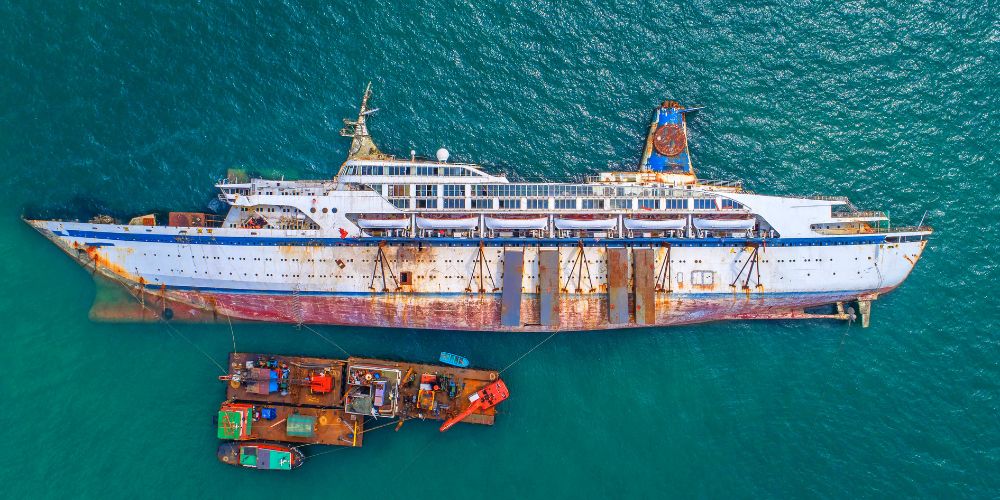
Has a cruise ship ever sunk?
Cruise ships have sunk in the past, but the instances are very rare. In the last 100 years, only 22 cruise ships have sunk, and some of those sinkings were either while berthed or while being towed.
Generally, the modern safety features on cruise ships mean that very few lives are lost if ships ever sink.
Sadly, there were some larger tragedies that occurred slightly over 100 years ago, including the Titanic and the slightly less well-known Empress of Ireland.
Lessons learned from these disasters have helped to keep people much safer in more recent times.
How many cruise ships have sunk?
Within the last 100 years, only 22 cruise ships have sunk, if you include river cruise ships and ocean liners. Almost 2,000 people have died in these incidents but over half of those can be attributed to ships sinking before 1940. Many of the incidents involved no loss of life at all.
Arguably the most famous cruise ship sinking in the last 100 years is that of the Costa Concordia. She sank in 2012 and is the only modern major ocean cruise ship serving passengers from around the world to have sunk during a cruise.
The cause of the sinking was the ship hitting a rock underwater, resulting from the human error of the ship’s captain who has since been found guilty of manslaughter.
How often do cruise ships sink?
Cruise ships very rarely sink, and when they do it is often when they don’t have passengers on board. Just over one cruise ship every 5 years has sunk in the last 100 years. Regarding sinking with casualties, that’s only one every 7 years.
In the last 50 years, there have been 15 cruise ships that have sunk. Of these, 5 occurred when no passengers were on board, and in another, there was an engine fire during a cruise but all passengers and crew were safely evacuated.
Only nine times since 1956 have passengers lost their life during a cruise, and of these, some were due to human error and one was a river cruise that hit a freak storm.
When was the last time a cruise ship sank?
The last cruise ship to sink was the Orient Queen. This ship was berthed in Beirut during the massive ammonium nitrate explosion of 2020 at the port. The ship suffered damage due to the explosion and sank that night. Two crew members were killed.
The last time a cruise ship sank with passengers on board was a Chinese river cruise ship in 2015, which hit an unexpected and severe storm that capsized the boat.
List of Sunken Cruise Ships
For the sake of this list, I’ve looked back just over 100 years, so that we cover everything from possibly the most famous cruise ship sinking ever.
Important – I’ve also decided to keep this list to cruise ships (both ocean and river), and ocean liners that served as cruise ships.
I’ve omitted passenger ferries, since this is specifically about cruise ships. I’ve also chosen not to include ships that served as a cruise ship for a small part of their life but were being used for other purposes when they sank. If the ship was mainly a cruise ship but was commandeered for war efforts, I’ve kept it in.
1. Titanic – 1912

Arguably the most famous cruise ship sinking in history and also one of the worst in terms of deaths, the Titanic sunk on her maiden voyage across the Atlantic Ocean after colliding with an iceberg.
The ship was not equipped with enough lifeboats to be able to hold everyone on board, which is one of the main reasons why it’s one of the deadliest maritime incidents in history too.
The fact that the ship sunk in such cold waters also played a part, as those not in lifeboats had almost no chance of survival.
The Titanic sinking has since become a major point of maritime history, with dedicated museums to the tragedy and, of course, the 1997 blockbuster movie.
2. Empress of Ireland – 1914
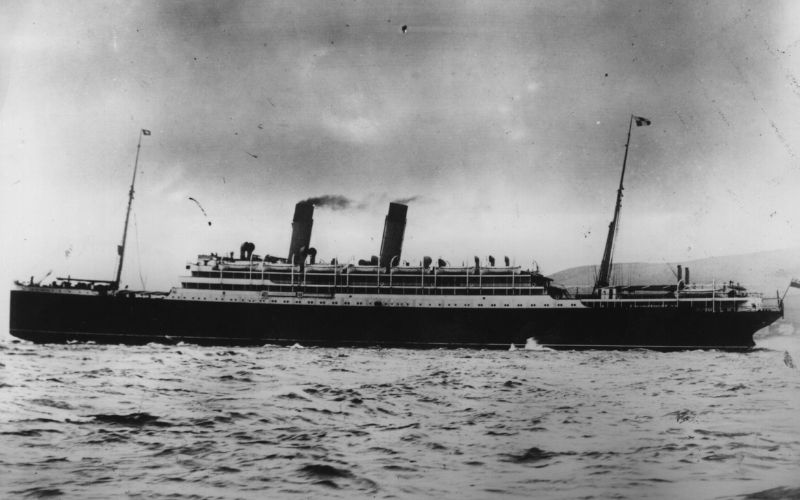
Often referred to as Canada’s Titanic – unsurprising considering how recent this was after the Titanic sank – the Empress of Ireland was a large passenger liner carrying almost 1,500 people. She sank after colliding with the Storstad, a Norwegian collier ship, during foggy conditions.
Both ships were aware of each other’s presence, having been sighted during clear conditions, but with fog rapidly surrounding the ships, they could only rely on whistles to communicate.
It wasn’t enough and the Empress of Ireland sank when struck, causing the deaths of 1,012 people, a mix of passengers and crew. This was the worst maritime disaster in Canada’s history.
3. Lusitania – 1915
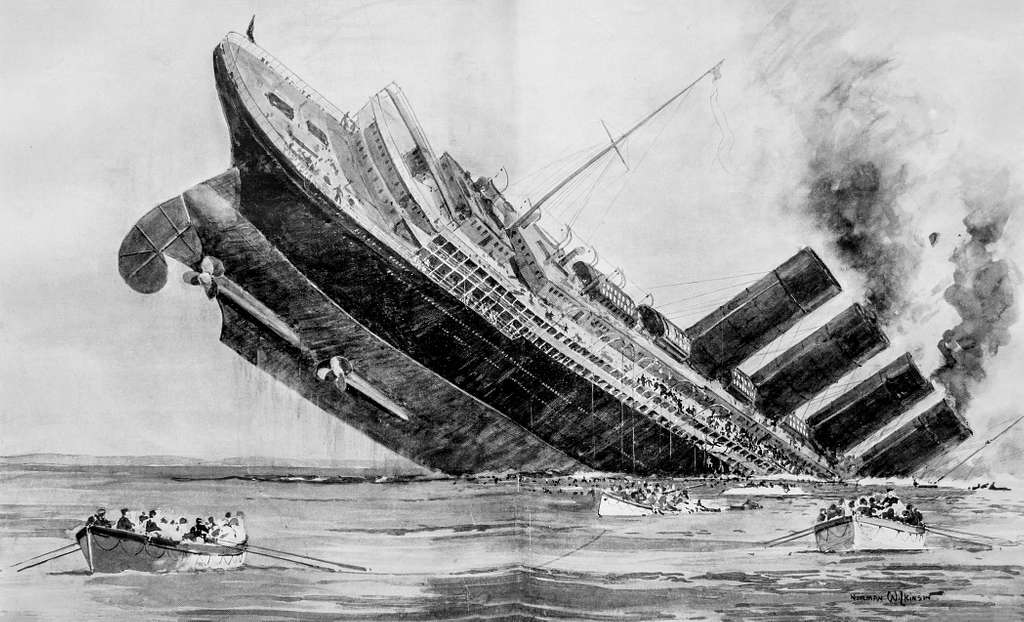
Lusitania was a cruise ship that was launched for Cunard Line in 1906 – the same Cunard Line that still operates cruise ships today. She was a British ocean liner that, for a few brief months, held the distinction of being the largest passenger ship in the world.
Unfortunately, she was a victim of the First World War. She sailed successfully for nine years and in that time completed 201 transatlantic crossings. However on her 202nd, travelling from New York to Liverpool, she was hit by a torpedo from a German U-Boat submarine off the south coast of Ireland.
Due to the size of the explosion and the speed of listing, only six lifeboats could be launched, and in total 1,198 passengers and crew lost their lives, with 764 survivors.
4. Britannic – 1916
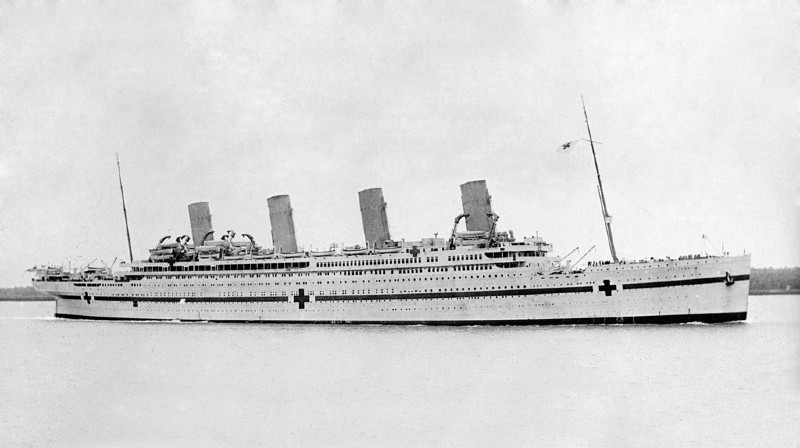
Sister ship of the Titanic, HMHS Britannic was the third of White Star Line’s Olympic Class of ocean liners and she was originally intended to serve as a passenger ship. However, just as she was due to launch, the First World War broke out.
In 1915, she began service as a hospital ship – the largest in the world. In 1916 she struck a German naval mine off the coast of a Greek island which caused her to sink just 55 minutes later.
Of the 1,066 people on board, 1,036 made it into lifeboats or the water and were rescued. 30 people sadly lost their lives.
5. Principessa Mafalda – 1927
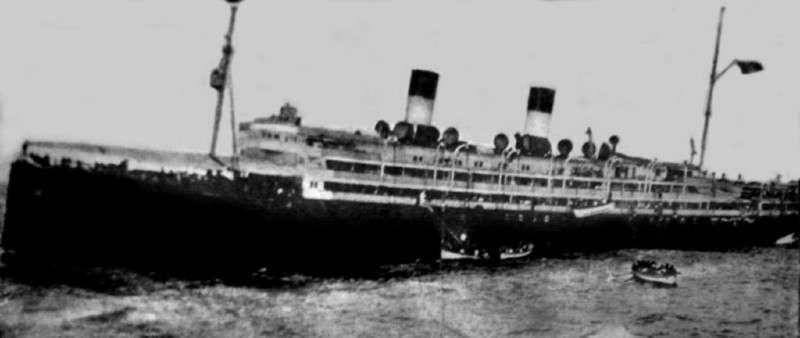
The SS Principessa Mafalda was an Italian cruise ship built in 1909, regularly making sailings between Genoa and Buenos Aires in Argentina.
She sank in 1927 off the coast of Brazil when a propeller shaft broke and damaged the hull of the ship. She sank slowly, but there was some confusion on board which meant that 314 people died of the 1,252 passengers and crew on the ship.
Her sister ship, Principessa Jolanda, actually sank earlier and would be on this list if I’d gone back slightly further, but she capsized and sank as she was launched in 1907. There were no causalities but, despite being brand new, the ship couldn’t be retrieved.
6. Saint-Philibert – 1931
The Saint-Philibert was a small cruise ship that would offer summer sailings around the Loire River and the French coastline. It’s unclear when she was first launched, but tragedy struck in 1931 when she sank.
There are multiple reasons for her sinking – the weather was extremely stormy, and the ship was way over capacity, with twice the expected load onboard. As passengers stood on the starboard side to view the storm, a freak wave combined with the weight of the passengers to capsize the ship. Almost 500 people died and only 8 survivors were accounted for.
7. Georges Philippar – 1932
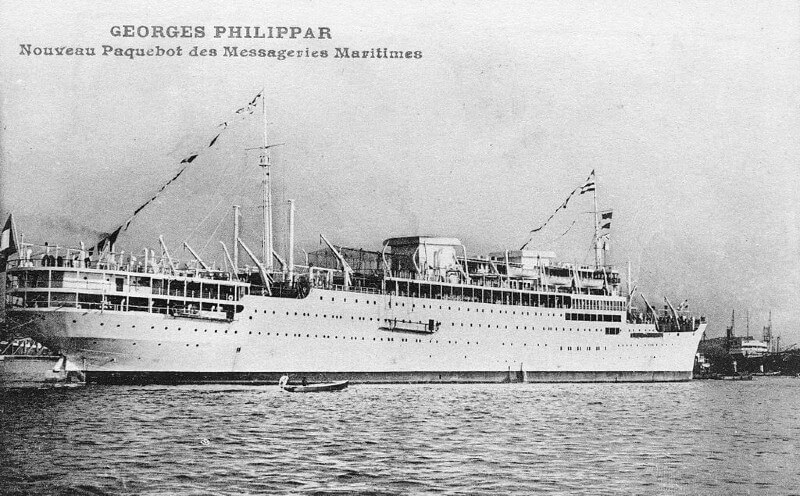
Public domain, via Wikimedia Commons
A French ocean liner, the Georges Philippar sank on her maiden voyage due to an electrical fault. She had sailed successfully to Yokohama, but on the return leg sank near Italian Somaliland.
The high voltage wiring used throughout the ship sparked from a malfunctioning light switch in one of the luxury cabins, setting the wood panel alight. 54 lives were lost.
There had been concerns about the quality of the ship before she sailed, but these were ignored due to worries about delay penalties to the build. Changes were made due to the sinking of the ship to make electrical wiring onboard much safer, including using an AC current and more modern circuit breakers.
8. SS Morro Castle – 1934
The SS Morro Castle was an ocean liner that was designed to make regular sailings between the US and Cuba. She launched in 1930, but just four years later would sink in tragic circumstances.
The cause of her sinking was a fire, which would gradually disable the ship as it burned through electrical cables and hydraulic lines used for steering the ship. 137 people lost their lives, with the blame placed at the feet of the crew who handled the emergency badly.
9. Empress of Britain – 1940
The Empress of Britain was another ship owned by the Canadian Pacific Railway Company to sink, and like the Lusitania, she was a victim of war, although this time it was the Second World War that caused her demise.
She first launched in 1930 and was formally completed in 1931, and served as an ocean liner sailing from Canada to Europe for nine years.
In October 1940, off the coast of Ireland, the ship was bombed from above, hit by two 250kg bombs. On board were 416 crew, 2 gunners and 205 passengers, consisting of military personnel and their families. 45 people died but most survived.
10. Andrea Doria – 1956
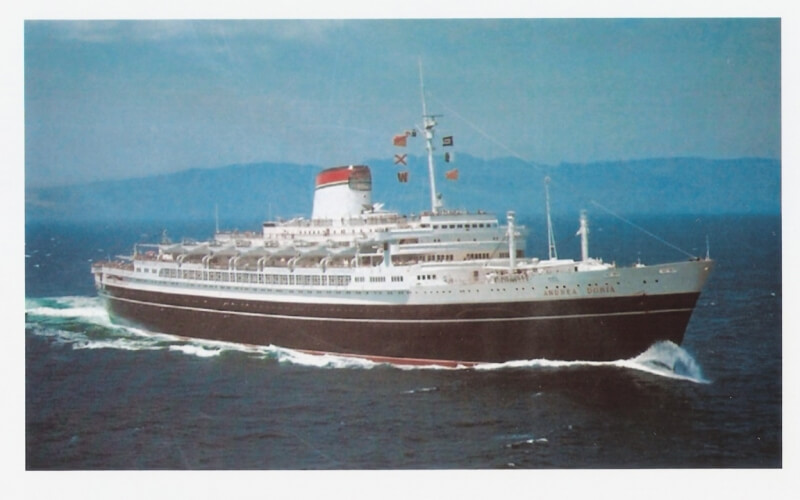
Public domain, via Wikimedia Commons
While still a tragic event in which 46 passengers and crew lost their lives, the sinking of the Andrea Doria demonstrated the impact that safety improvements had made to ships since the sinking of the Titanic.
Andrea Doria was struck by another ship, the Stockholm, and immediately began to list heavily which made many of the lifeboats inaccessible.
However, the ship sank slowly, and the crew made use of the improved communications systems and training and successfully got 1,660 passengers and crew to safety.
The lost lives were a direct result of the collision and not the sinking, which occurred the day after the initial impact.
11. Bianca C – 1961
The Bianca C is a unique entry on this list as it has somehow been sunk not once, but twice. The ship started life as a passenger ferry and was scuttled by the Germans during the Second World War. The hull was raised from the water and the ship was refitted as a cruise ship.
Eventually sold to Costa Line, the forerunner company of Costa Cruises, she was given the name Bianca C. She sank for a second time in 1961 after an explosion in the engine room. The explosion killed one crew member but everyone else made it off the ship.
12. Angelina Lauro – 1979
The Angelina Lauro is a ship with a storied history. She spent most of her life as a passenger ferry under the name MS Oranje, having first launched in 1939. As with many ships at the time, she was commandeered for the war, serving as a hospital ship. In 1965 she joined Lauro Lines and in 1972 she was refitted as a cruise ship.
In 1979, whilst being chartered to Costa Lines, the ship caught fire in port at Saint Thomas. The fire burned for several days and the ship was declared a total loss. While being towed to a scrapyard she sank later that year. No lives were lost.
13. MS Mikhail Lermentov – 1986

U.Gomez, CC BY-SA 4.0 , via Wikimedia Commons
The MS Mikhail Lermentov was an ocean liner that was operated by the Baltic Shipping Company out of the Soviet Union. She entered service in 1972 and was later converted into a cruise ship, being fully converted in 1982.
In 1986, the ship was operating a cruise from Sydney, exploring New Zealand on a two-week itinerary. While sailing past Cape Jackson, around 30 miles northwest of Wellington, the ship hit rocks.
Of the 372 passengers and 348 crew onboard, most were able to make it into a lifeboat, although it was a close call – only 20 minutes after the last passenger was recused, the ship completely sunk. One person lost their life – a crewmember who remained with the ship, Pavel Zagladimov.
14. SS Admiral Nakhimov – 1986
Remember when I said Bianca C was unique because she had sunk twice? That’s still true, but SS Admiral Nakhimov actually beats her, since this ship sunk three times in total. Originally a hospital ship for the Nazis, the ship was given to the Soviet Union according to reparations, even though she was underwater. She was raised, sank again, and then raised once more.
Her final sinking occurred in 1986 while operating cruises around the Black Sea. She collided with a freighter, despite the freighter’s Captain radio-ing to say they would make sure to avoid the collision. 423 people out of the 1,234 on board died in the incident.
15. MV Jupiter – 1988
The MV Jupiter was a Greek-registered ship that offered cruises around the Mediterranean. In 1988, she sank just 40 minutes after leaving Piraeus, and on board were 391 British schoolchildren and 84 adults taking part in a study cruise. There were also 110 crew.
The cause of the incident was a collision with an Italian freight ship. Sadly, four people died in the sinking – one pupil, one teacher and two crew members.
16. Achille Lauro – 1988
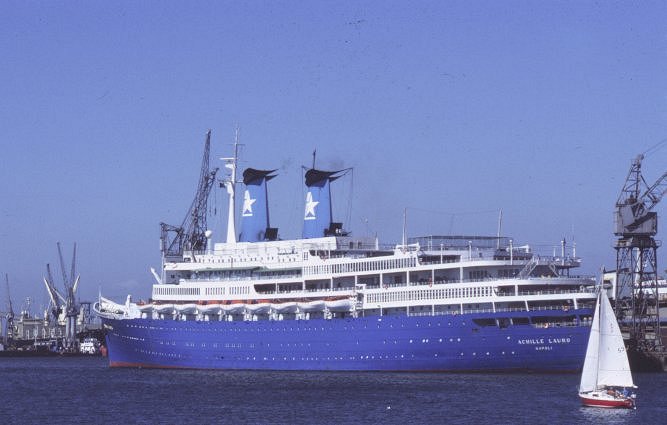
Photo: D. R. Walker, CC BY-SA 3.0, via Wikimedia Commons
The MS Achille Lauro was a cruise ship that was originally built for a Dutch company but eventually ended up being in the hands of StarLauro, which would go on to form part of MSC Cruises.
The ship underwent a number of incidents in a storied life, including a hijacking in 1985, two serious collisions with other ships, and four onboard fires.
The last of these sunk the ship off the coast of Somalia. There were 979 passengers and crew on board and of those, two, unfortunately, died during the evacuation of the ship.
17. MTS Oceanos – 1991
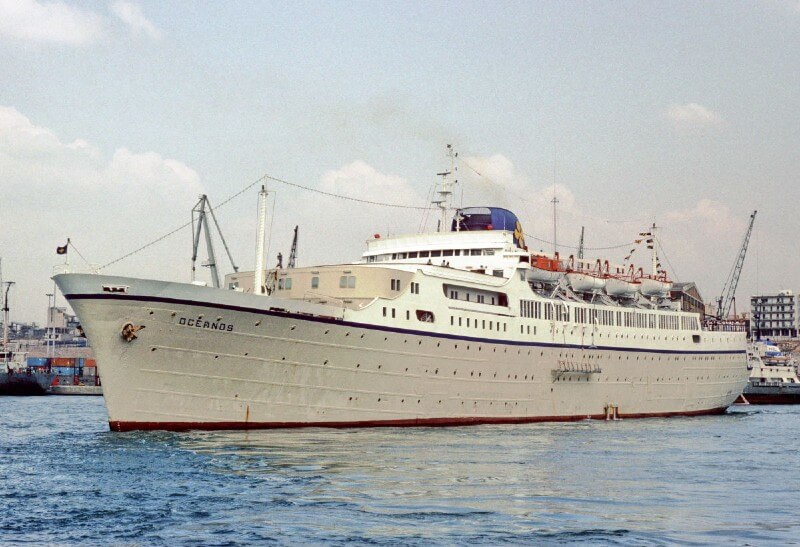
By Peter J. Fitzpatrick, CC BY-SA 4.0
The MTS Oceanos was another ship sailing from Greece that sank, only three years after the MV Jupiter. The cause was excessive flooding, which was believed to have been caused by freak waves breaking apart a ventilation pipe that had been insufficiently repaired.
All 581 passengers and crew survived, but with no thanks to the captain and some of the crew, who were later convicted for abandoning the ship. It was the ship’s entertainers who sounded the alarm and helped get every passenger to safety.
18. Sun Vista – 1999
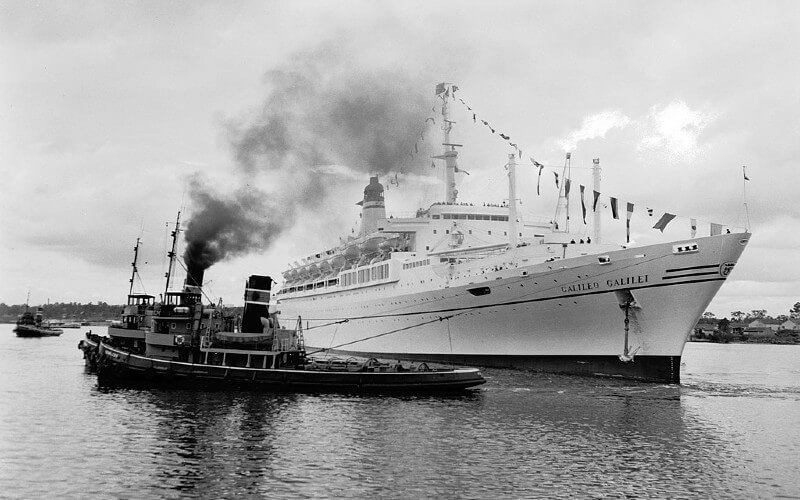
Queensland State Archives, CC BY-SA 4.0, via Wikimedia Commons
Originally launched as the SS Galileo Galilei for the Lloyd Triestino line, the Sun Vista actually sailed as the Meridian for Celebrity Cruises for 7 years (the first ship for the cruise line) before being transferred to Sun Cruises and being renamed the Sun Vista in 1997.
She sank just two years later due to an engine room fire on 20th May 1999 which cut all power, resulting in the ship going down the following morning at around 1 am. With modern safety procedures in place, the entirety of the ship’s passengers and crew (1,090 total) were evacuated with no casualties.
19. SeaBreeze – 2000
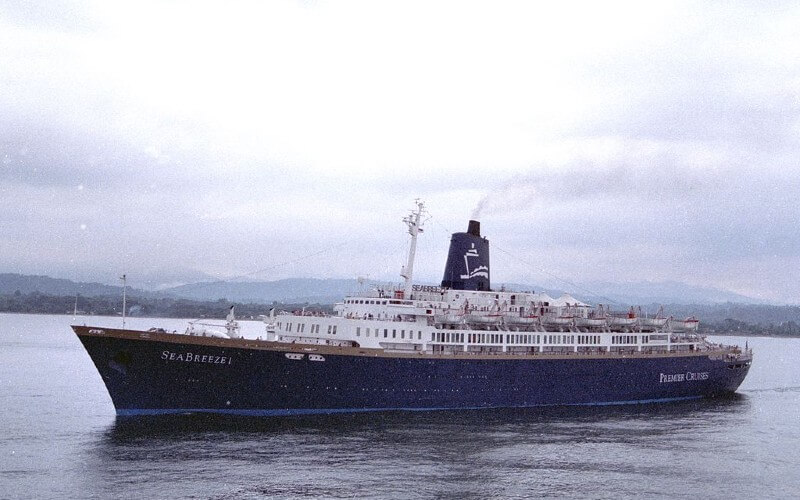
Leo Johannes, CC BY-SA 4.0, via Wikimedia Commons
The SeaBreeze was a cruise ship originally owned by Costa Cruises, first launching in 1958. She was then owned by Premier Cruises from 1983 until she sank in 2000, after the cruise line had already gone out of business.
The cause of the sinking was the boiler breaking off, which caused sufficient damage to sink the ship. There was a lot of controversy at the time, as some believed it was an intentional incident (the scrap value of the ship was around $6 million but it was insured for $20 million). Only 34 crew members were on board when she sank, and all were rescued.
20. Britanis – 2000
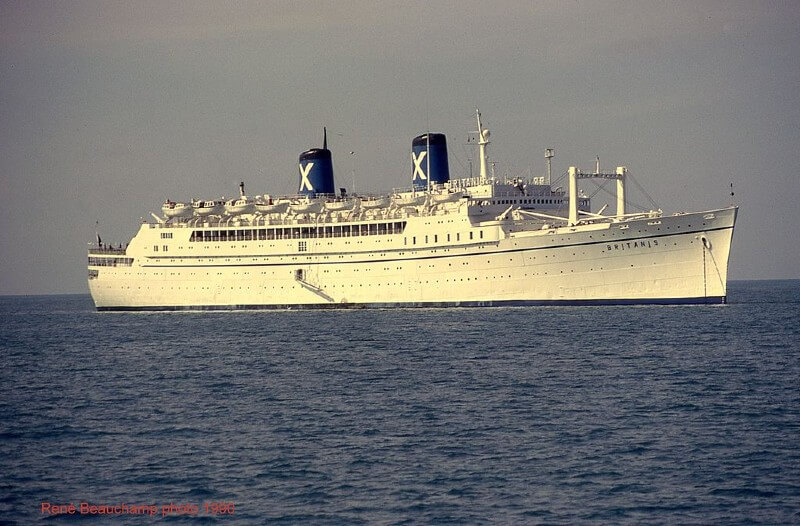
René Beauchamp, CC BY-SA 4.0, via Wikimedia Commons
One of the less dramatic incidents on this list, the Britanis had been a cruise ship for Chandris Lines, under the Fantasy Cruises brand. She was then sold to AG Belofin Investments when Chandris decided to focus on its Celebrity Cruises brand instead.
The ship was renamed Belofin-1 but never cruised. Instead, in 2000, she was towed towards shipbreakers in India where she was to be scrapped, but she began to take on water and list.
As there was nobody on board to correct the list, the only option was for the tugboat to cut the ship free and allow it to capsize and sink off the coast of Cape Town.
21. MV Explorer – 2007
The MV Explorer was a small cruise ship that had many owners in her life, launching first in 1969. She has the honour of being the first cruise ship specifically used for cruises to the Antarctic Ocean. Unfortunately she also has the record of being the first ship to sink there too.
She struck an iceberg in 2007, and everyone on the ship took to the lifeboats, including 91 passengers, 54 crew and 9 expert guides. They were rescued by the MS Nordnorge after drifting for five hours.
22. MS Sea Diamond – 2007
The MS Sea Diamond was a small cruise ship that was originally built for Birka Line, sailing as Birka Princess. After 20 years of successful operation, she was transfered to Louis Hellenic Cruise Lines, but just a year later she ran aground in Santorini.
Ultimately the ship’s Captain was blamed and jailed, although it came to light that the sea charts for the area were inaccurate and the reef the ship struck was 131 metres from shore, not 57 metres as marked on the charts. Over 1,000 passengers and crew were rescued but two French passengers went missing and were never found, presumed dead.
23. Costa Concordia – 2012
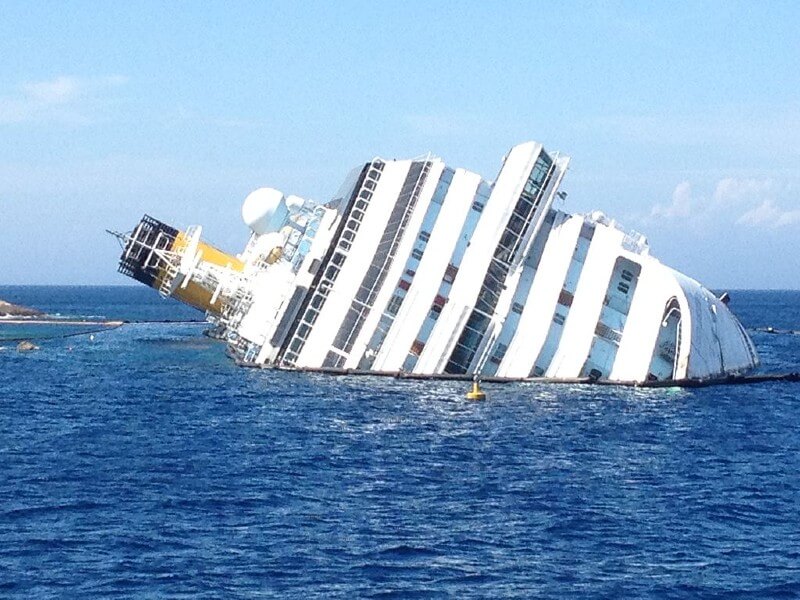
Paolodefalco75, CC BY-SA 3.0, via Wikimedia Commons
If the Titanic is the most famous cruise ship sinking in history, then Costa Concordia would take that title for modern history. The Costa Cruises ship sank after striking an underwater rock off the coast of Tuscany, sailing closer to the island than it should have done.
There were 4,252 people on board the ship including over 3,200 passengers. Most were rescued but 34 people did lose their lives including 27 passengers, 5 crew and 2 members of the salvage team.
Captain Francesco Schettino was found to be at fault and found to be guilty of manslaughter, and is now serving a 16-year prison sentence.
Suggested read: Where Is The Costa Concordia Now?
24. Eastern Star – 2015
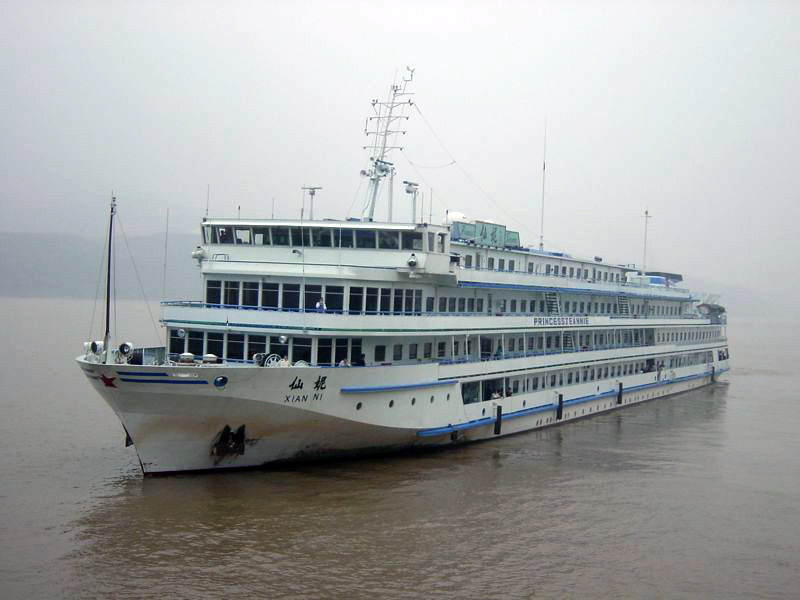
davidd from Waialua, Oahu, Hawaii, USA, CC BY 2.0, via Wikimedia Commons
Officially named ‘Dongfang zhi Xing’, this Chinese river cruise ship would make regular sailings along the Yangtze River around the Three Gorges. In 2015, while sailing from Nanjing to Chongqing, she was caught in a storm and sank in waters just 15 metres deep.
There were 456 people on board the ship and tragically only 12 people survived – the remaining 442 bodies were all found. Most of the passengers were in their 60s or 70s and the ship capsized and sank very quickly.
Improvements have since been made to the communication of severe weather reports to river cruise ships, and the Chinese government also concluded that negligence played a part, with 43 people punished due to flaws in the management of the company.
25. Ocean Dream – 2016
Of all the ships on this list, few have had quite the history of the Ocean Dream. Originally ordered by Norwegian Cruise Line, and due to be named Seaward, the shipyard underwent financial troubles and cancelled the order. NCL complained, so the shipyard agreed to continue working, but then NCL sold the ship to P&O where she sailed as Spirit of London.
She later became Sun Princess for Princess Cruises, then for Premier Cruises as Starship Majestic, and was chartered by Disney. She later became New Flamenco for Festival Cruises, then Flamenco 1, then Ocean Dream for three more cruise lines. She sank in Thailand in 2016 after having been abandoned for a year, with no casualties.
26. Orient Queen – 2020
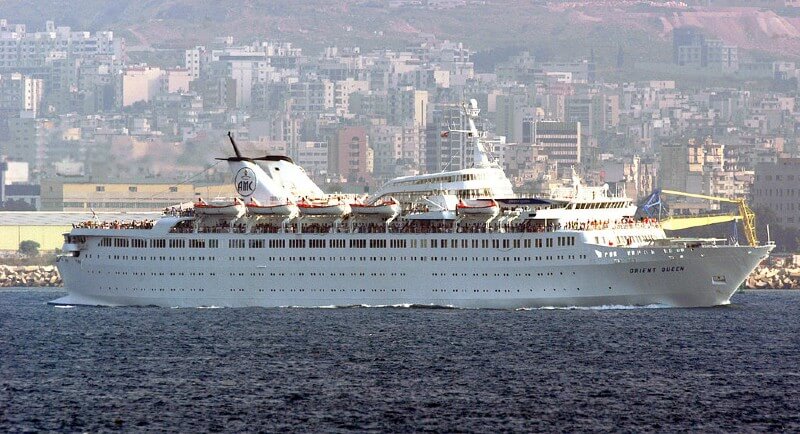
United States Navy, Mass Communication Specialist 1st Class Robert J. Fluegel, Public domain, via Wikimedia Commons
Orient Queen was a cruise ship that was owned by the Abou Merhi Group in Lebanon. Sailing from Beirut it offered cruises to the eastern Med, including ports in Turkey and Greece.
While berthed in port and without any passengers on board, the ship sank in 2020 after a massive ammonium nitrate explosion at the port. There were two crew on the ship that were killed as a result of the ship sinking. There were many other ships also in port at the time that suffered damage, although Orient Queen was the only cruise ship to sink.
What are the odds of a cruise ship sinking?
The odds of a cruise ship sinking are extremely low. Only 11 ocean cruise ships have sunk while on a cruise in the last 50 years. Assuming an average of 100 sailings per ship per year, and an average of 150 cruise ships in that time, that is odds of 1 in 68,000.
That’s not exact, obviously – more ships have been built more recently and there are over 300 cruise ships currently sailing, so an average of 150 for the last 50 years is probably accurate. And some ships sail longer itineraries and some sail regular 3-4 day cruises. But that’s a rough guide to your odds.
And that’s just of the cruise ship sinking. The chances of dying in a cruise ship sinking incident are even lower since most people are saved – around 1 in 5 million.
To demonstrate how safe cruising is – the odds of dying from a lightning strike are somewhere between 1 in 84,000 and 1 in 130,000 depending on which stat you believe. There’s apparently a 1 in 2 million chance of dying falling off a chair, and a 1 in 2.3 million chance of being killed by a falling ladder – and not when you’re on it.
How verified these stats are is questionable but the point is that cruise ships are an extremely safe way of travelling. Sinkings are rare, and fatalities even rarer.
Why don’t cruise ships sink?
There are so many reasons why cruise ships don’t sink. Their basic design means that they are engineered to keep them upright, with ballast tanks preventing the ship from tipping over.
Add in state-of-the-art navigation systems and safety mechanisms, the expert crew that are trained in every potential outcome, and of course the threat of insurance companies ensuring that ships are all maintained to the highest standards, and you’ve nothing to fear.
You can read more about this here: Why Cruise Ships Don’t Tip Over.
The only ocean cruise ship to sink with passengers on-board within the last 15 years was human error, and they’ve been found guilty at a criminal trial. Cruise ship captains were already vetted for their safety standards but now even more so – it’s unthinkable that anything like that could happen again.
The Bottom Line
If you were reading this guide because you were interested in cruise ship history, hopefully, I’ve been able to shed some light.
More importantly, if you’re someone worried about being on a cruise ship then I hope you now feel reassured that you don’t have to be. The stats show that sinkings are exceptionally rare, and even when they do happen there are plenty of safety procedures in place.
So, now nothing’s stopping you from enjoying an amazing cruise holiday.
Related Posts:
- What Happens If A Cruise Ship Is Hit By A Rogue Wave?
- Do Cruise Ships Have Morgues?
- Why Cruise Ships Blow Their Horns
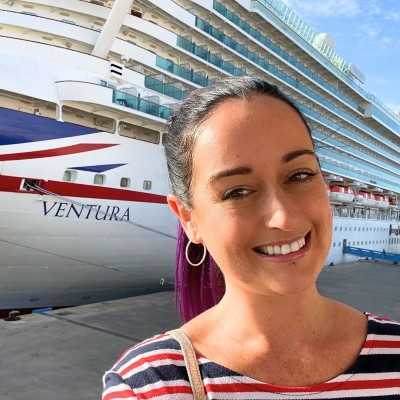
Jenni Fielding is the founder of Cruise Mummy. She has worked in the cruise industry since 2015 and has taken over 30 cruises. Now, she helps over 1 million people per month to plan their perfect cruise holidays.

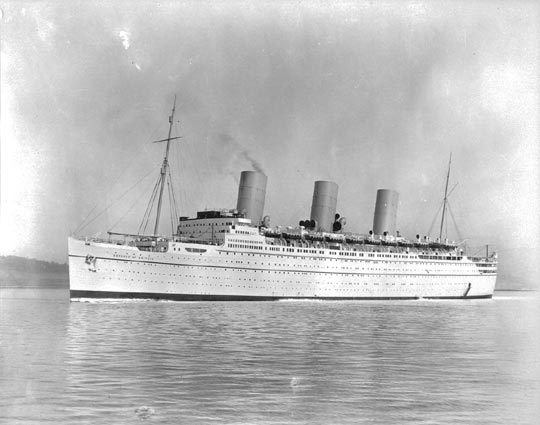
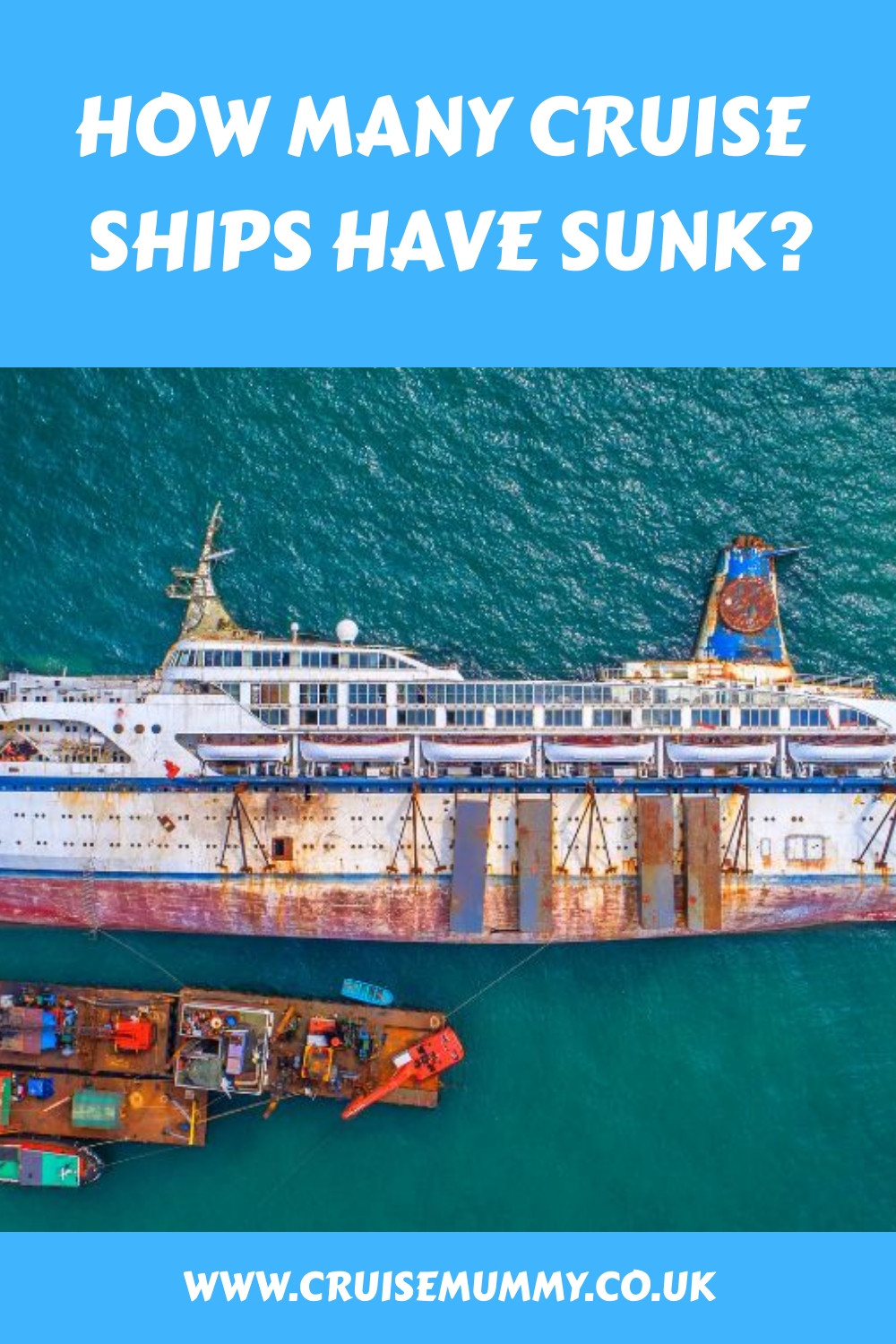

I will NEVER go on a cruse ship or any ship. Not for me. No thanks!
A couple of omissions Jenni
MV Wilhelm Gustloff 30 January 1945, the 9,400 people died. the biggest maritime disaster in History.
SS Eastland on the Chicago River in Chicago on July 24, 1915. – 844 lives.
Thanks for this. I’m keeping the list to just cruise ships, otherwise it will become very long if I were to include all other types of vessels too. Thanks for your understanding. Jenni
You actually missed quite a few ocean liners/cruise ships that have gone down from what appears to be c.1912-present. The Lusitania, Mikhail Lermontov, Empress of Britain, and the Achille Lauro for example. While it is true that passenger vessels do not routinely sink anymore, you’re downplaying the number of ships that have made their way to the bottom. Oh, and the Doña Paz.
Thank you so much for your help in identifying those that I missed. I have added them in. Jenni
Hi! MY husband and I are taking our first cruise in October 2023. After seeing all the storms at sea videos , I am indeed very much comforted by this info! TY! I was thinking to cancel the cruise. I am not now! ♥
Hi Jenny. I’m so glad to have been able to put your mind at rest. I hope you enjoy your cruise. Jenni
I poster in wrong place. You forgot the Oceanos in 1991. No lives lost but the crew abandoned ship and the passengers while the ship sank.
Ah yes, you’re right I missed one! Thanks for your help, I’ll add that in. Jenni
There’s also the Sea Diamond, sunk during a cruise in 2007, with 2 lives lost.
The Oceanus? Not a comforting thought that the crew abandoned ship and passengers while the ship sank
If I remember correctly the crew or Captain were Greek, and it was the British entertainment team who got the passengers off while the captain and officers scarpered in a lifeboat, whether they were ever held accountable I don’t know
You have missed out the Jupiter cruise ship, 21st October 1988, leaving Piraeus harbour in Greece. There was loss of life, 2 crew members, a teacher and a pupil. I was on it!
Just because we were school children, doesn’t mean we should be forgotten about.
Hi Julia, thank you for bringing that to my attention. I didn’t find information on this when I researched the post in the first place, so I apologise that it wasn’t included originally. I’ve added it now. It certainly wasn’t my intention to make you feel forgotten.
This is great, but I feel like you should have specified that the Titanic and Brittanic were Ocean liners, not cruise ships.